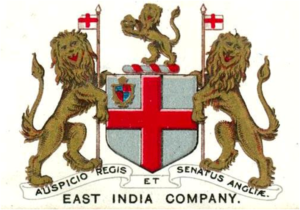The British East India Company — the Company that Owned a Nation (or Two)
George P. Landow, Professor of English and the History of Art, Brown University
The East India Company is, or rather was, an anomaly without a parallel in the history of the world. It originated from sub-scriptions, trifling in amount, of a few private individuals. It gradually became a commercial body with gigantic resources, and by the force of unforeseen circumstances assumed the form of a sovereign power, while those by whom its affairs were directed continued, in their individual capacities, to be without power or political influence. — Bentley’s Miscellany 43 (1858)
One of the strangest parts of the history of the British Empire involves that commercial venture generally known as the East India Company, though its original name when founded by royal charter on the very last day of 1600 was the Governor and Company of Merchants of London Trading into the East Indies. As its name suggests, the company was the enterprise of London businessmen who banded together to make money importing spices from South Asia. For centuries the valuable spice trade with the East Indies (as they were long known) relied on land routes across Asia and the Middle East, but by the sixteenth century, the superior navigational technology and skills of the Portuguese for the first time permitted Europeans to cut out intermediaries and hence make themselves far greater profits. The Spanish and Portuguese had a monopoly of the East Indies spice trade until destruction of the Spanish Aramada in 1588, which permitted the British and Dutch to seek their share of this wealthy import business.
The company with the long name first entered the spice trade in the form of an old-fashioned or early capitalist venture, essentially conducting each voyage as a separate business venture with its own subsribers or stock-holders. This approach lasted for a dozen years, and then in 1612 the company switched to temporary joint stocks and finally to permanent joint stocks in 1657. Supposedly a monopoly, the company evenentually faced competition from another group of English investors and merchants, and the two merged in 1708 as the United Company of Merchants of England Trading to the East Indies.
According to the Encyclopedia Britannica,
The company met with opposition from the Dutch in the Dutch East Indies (now Indonesia) and the Portuguese. The Dutch virtually excluded company members from the East Indies after the Amboina Massacre in 1623 (an incident in which English, Japanese, and Portuguese traders were executed by Dutch authorities), but the company’s defeat of the Portuguese in India (1612) won them trading concessions from the Mughal Empire. The company settled down to a trade in cotton and silk piece goods, indigo, and saltpetre, with spices from South India. It extended its activities to the Persian Gulf, Southeast Asia, and East Asia.
The company’s encounters with foreign competitors eventually required it to assemble its own military and administrative departments, thereby becoming an imperial power in its own right, though the British government began to reign it in by the late eighteenth century. Before Parliament created a government-controlled policy-making body with the Regulating Act of 1773 and the India Act eleven years later, shareholders’ meetings made decisions about Britain’s de facto colonies in the East. The British government took away the Company’s monopoly in 1813, and after 1834 it worked as the government’s agency until the 1857 India Mutiny when the Colonial Office took full control. The East India Company went out of existence in 1873.
During its heyday, the East India Company not only established trade through Asia and the Middle East but also effectively became of the ruler of territories vastly larger than the United Kingdrom itself. In addition, it also created, rather than conquered, colonies. Singapore, for example, was an island with very few Malay inhabitants in 1819 when Sir Stamford Raffles purchased it for the Company from their ruler, the Sultan of Johor, and created what eventually became one of the world’s greatest trans-shipment ports.
In: victorianweb.org

